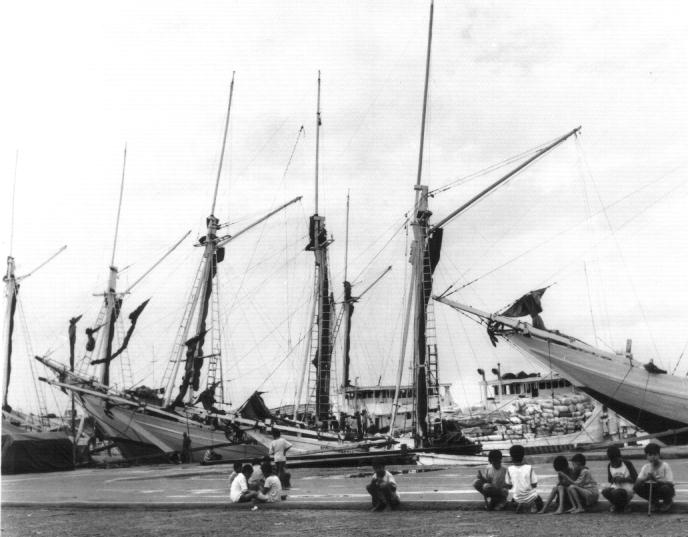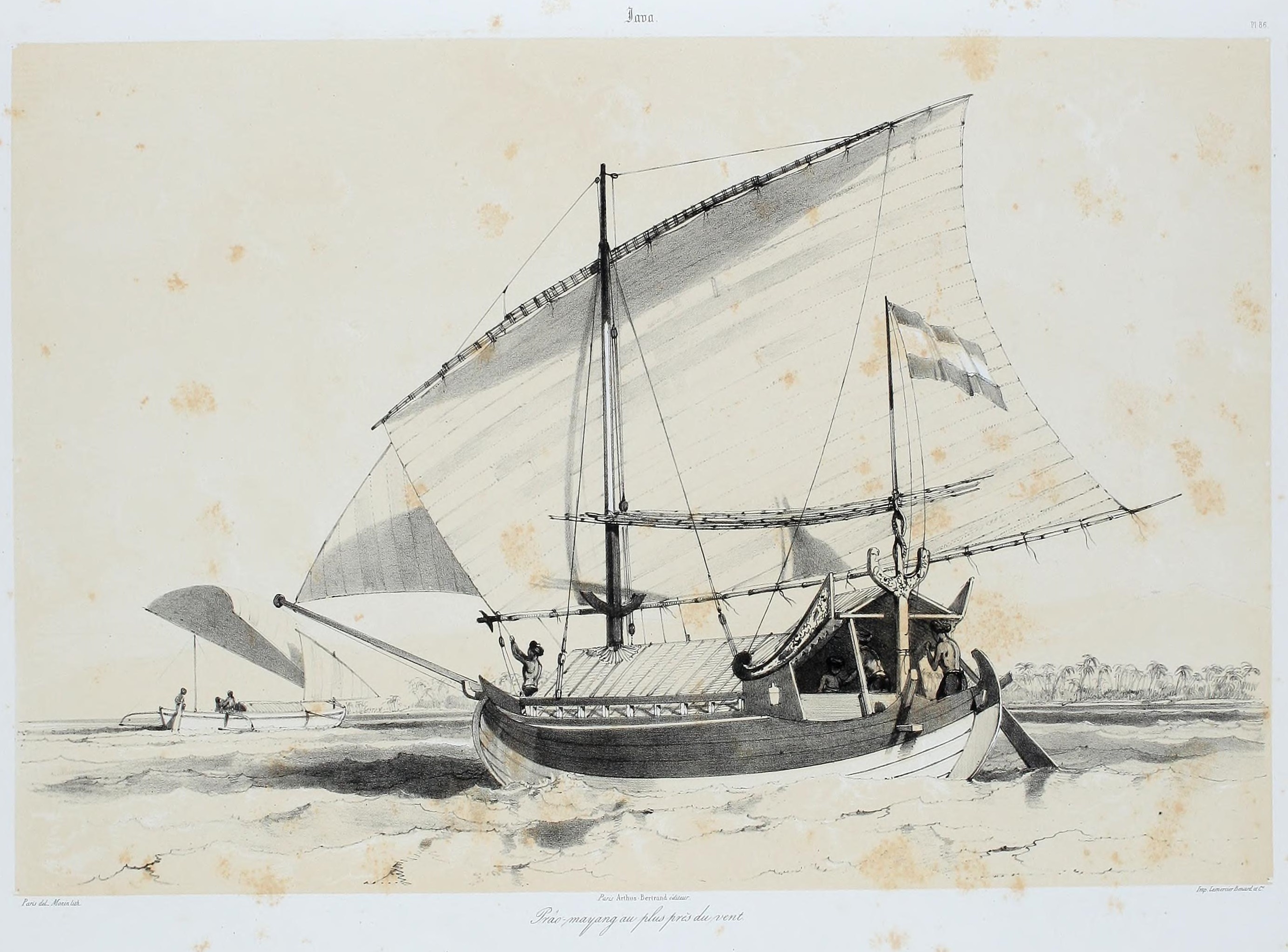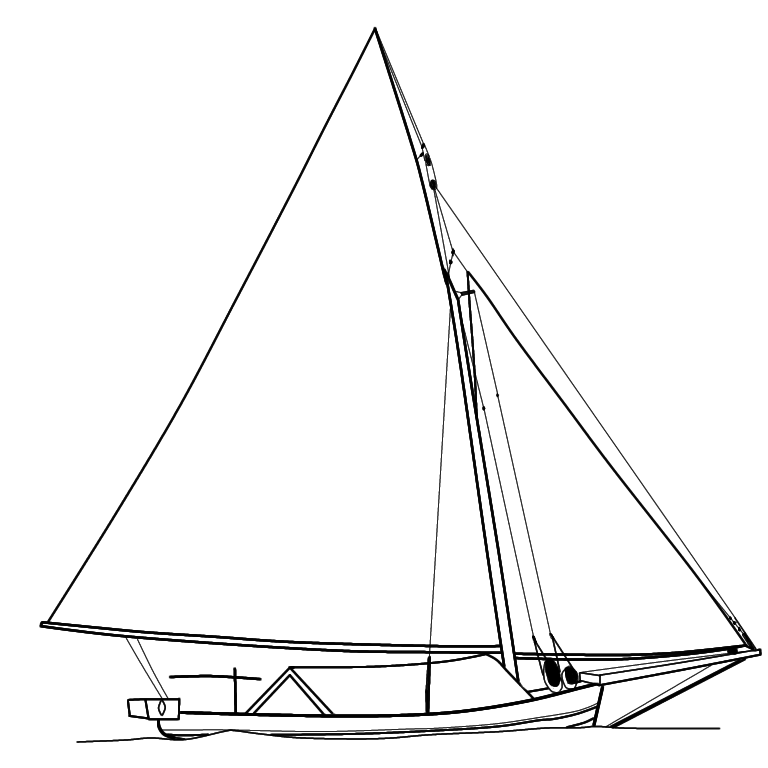|
Orembai
Orembai or Arombai is a type of plank boat from the Maluku Islands of Eastern Indonesia. It is mainly used for fishing and transport. This vessel is used as far as Batavia, where in the 17th century it became popular to go out "''orembaaien''" on an evening rowing on the river or city canals. Etymology The name ''orembai'' or ''arumbai'' is probably comes from the adapted Malay word ''rembaya'', which means state ship, with Portuguese prefix 'o'. In other variants of language they are also called ''orembaai'', ''arambaai'', ''arobail'', ''arubai'', ''arubaillo'', ''arumbai'', ''arumbae'', ''oranbai'', ''oranbaik, orang-bays,'' and ''corambay''. Martin says that the name ''orembai'' is a contraction for ''orang baik'' ("good man") and comes from the era of the Hongi voyages, i.e. these boats are the opposite of ''Hongitocht'' kora kora, which is a war vessel. Description It is characterized by being equal-ended, with the prow and the stern both rising up abruptly into a ... [...More Info...] [...Related Items...] OR: [Wikipedia] [Google] [Baidu] |
Pinisi
Literally, the word pinisi refers to a type of rigging (the configuration of masts, sails and ropes (‘lines’)) of Indonesian sailing vessels. A pinisi carries seven to eight sails on two masts, arranged like a gaff- ketch with what is called 'standing gaffs' — i.e., unlike most Western ships using such a rig, the two main sails are not opened by raising the spars they are attached to, but the sails are 'pulled out' like curtains along the gaffs which are fixed at around the centre of the masts. As is the case with many Indonesia sailing craft, the word 'pinisi' thus names only a type of rig, and does not describe the shape of the hull of a vessel that uses such sails. Pinisi-rigged ships were mainly built by the Konjo-speaking people of Ara, a village in the district of Bontobahari, Bulukumba regency, South Sulawesi, and widely used by Buginese and Makassarese seafarers as a cargo vessel. In the years before the eventual disappearance of wind-powered transport in course ... [...More Info...] [...Related Items...] OR: [Wikipedia] [Google] [Baidu] |
Mon (boat)
Tomako or tomoko is a large war canoe from the Solomon Islands. The name "tomako" is used in New Georgia in the Roviana language. It is also known as magoru in Marovo, niabara in Vella Lavella, mon in Bougainville, ora in Makira, and iola or ola in Malaita and Ulawa. Tomako were narrow and usually between in length. They did not possess outriggers or sails and were propelled solely by paddling. They were built by fitting planks edge-to-edge which are then "sewn" together and caulked with a paste made from the nut of the tree ''Parinarium laurinum''. They could carry 30 to 50 warriors, and were used in raiding expeditions for slaves or for headhunting. They were characteristically crescent-shaped, with sharply upturned prows and sterns (reaching up to high) that were decorated with fringes of cowrie shells, nautilus shells, and mother-of-pearl, as well as intricate carvings (Roviana: ''nguzunguzu''; Marovo: ''toto isu''). These carvings are usually of spirit animals or war ... [...More Info...] [...Related Items...] OR: [Wikipedia] [Google] [Baidu] |
Maluku Islands
The Maluku Islands (; Indonesian: ''Kepulauan Maluku'') or the Moluccas () are an archipelago in the east of Indonesia. Tectonically they are located on the Halmahera Plate within the Molucca Sea Collision Zone. Geographically they are located east of Sulawesi, west of New Guinea, and north and east of Timor. Lying within Wallacea (mostly east of the biogeographical Weber Line), the Maluku Islands have been considered as a geographical and cultural intersection of Asia and Oceania. The islands were known as the Spice Islands because of the nutmeg, mace and cloves that were exclusively found there, the presence of which sparked colonial interest from Europe in the sixteenth century. The Maluku Islands formed a single province from Indonesian independence until 1999, when it was split into two provinces. A new province, North Maluku, incorporates the area between Morotai and Sula, with the arc of islands from Buru and Seram to Wetar remaining within the existing Maluk ... [...More Info...] [...Related Items...] OR: [Wikipedia] [Google] [Baidu] |
Sailboat Types
A sailboat or sailing boat is a boat propelled partly or entirely by sails and is smaller than a sailing ship. Distinctions in what constitutes a sailing boat and ship vary by region and maritime culture. Types Although sailboat terminology has varied across history, many terms have specific meanings in the context of modern yachting. A great number of sailboat-types may be distinguished by size, hull configuration, keel type, purpose, number and configuration of masts, and sail plan. Popular monohull designs include: Cutter The cutter is similar to a sloop with a single mast and mainsail, but generally carries the mast further aft to allow for a jib and staysail to be attached to the head stay and inner forestay, respectively. Once a common racing configuration, today it gives versatility to cruising boats, especially in allowing a small staysail to be flown from the inner stay in high winds. Catboat A catboat has a single mast mounted far forward and does not ca ... [...More Info...] [...Related Items...] OR: [Wikipedia] [Google] [Baidu] |
Knabat Bogolu
Knabat bogolu is a type of traditional war vessel from Mentawai Islands Regency, Mentawai islands, west Sumatra, Indonesia. Background This vessel is shaped like a kora kora, but with different outrigger boom placement. Like kora kora, it also has deckhouse at the center of the hull. It has two main booms which slope down to the float (''Outrigger boat, katir'' in Malay language) and each has an accessory boom.Haddon (1920). p.78. A boom-spar is located above the vessel, one end of which rests on the roof.Haddon (1920). p.74. The float (''katir'') is double on each side. It has two masts, each rigged with narrow, very high sails from bamboo and palm leaf.Nooteboom (1932). p. 64. The stern of the vessel is more highly arched than the bow. Both the bow and the stern had decorative tufts and ropes. The roofing is solid through the entire length, about 30–40 ft (9.1–12.2 m) long. At the bottom of this shelter weapons and food are stored in the hold of the vessel. When going to ... [...More Info...] [...Related Items...] OR: [Wikipedia] [Google] [Baidu] |
Karakoa
''Karakoa'' were large outrigger warships from the Philippines. They were used by native Filipinos, notably the Kapampangans and the Visayans, during seasonal sea raids. ''Karakoa'' were distinct from other traditional Philippine sailing vessels in that they were equipped with platforms for transporting warriors and for fighting at sea. During peacetime, they were also used as trading ships. Large ''karakoa'', which could carry hundreds of rowers and warriors, were known as ''joangas'' (also spelled '' juangas'') by the Spanish. Panday Piray of Pampanga, Philippines was also known for forging heavy bronze lantaka to be mounted on Lakan's (Naval Chief/Commander) ships called 'caracoas' doing battle against the Spanish invaders and cannons were also commissioned by Rajah Sulayman for the fortification of Maynila. By the end of the 16th century, the Spanish denounced ''karakoa'' ship-building and its usage. It later led to a total ban of the ship and the traditions assigned to it. I ... [...More Info...] [...Related Items...] OR: [Wikipedia] [Google] [Baidu] |
Pencalang
Pencalang is a traditional merchant ship from Nusantara. Historically it was called as pantchiallang or pantjalang. It was originally built by Malay people from the area of Riau and the Malay Peninsula, but has been copied by Javanese shipwrights.Liebner, Horst H. (2016). ''Beberapa Catatan Akan Sejarah Pembuatan Perahu Dan Pelayaran Nusantara''. Jakarta: Indonesian Ministry of Education and Culture. By the end of the 17th century this ship has been built by Javanese and Chinese shipbuilders in and around Rembang. However it was a popular choice for Balinese skippers followed by Sulawesian skippers. Etymology The word ''pencalang'' comes from Malay word, which has now been absorbed into Indonesian language, namely ''calang'' and ''mencalang'', which means "to scout", "to recon", and "to peek". Therefore, pencalang can be interpreted as "a boat used for spying" or "recon boat". According to VOC glossarium, the Malay word ''pentjalang'' means "ship that was sent on the lookout", ... [...More Info...] [...Related Items...] OR: [Wikipedia] [Google] [Baidu] |
Padewakang
Padewakang were traditional boats used by the Bugis, Mandar, and Makassar people of South Sulawesi. Padewakang were used for long distance voyages serving the south Sulawesi kingdoms. Etymology No-one quite seems to know the origin of the name ''padewakang,'' though some have suggested that it stems from Dewakang Island, an important navigational landmark between Sulawesi and Java. Dutch records from the 1735 mention letters from Sulawesi arriving in Batavia ‘per praauw Paduackang’. According to Horridge, the words ''padewakang'', ''paduwakang'' (Sulawesi) and ''paduwang'' (Madura) have its roots from word ''wa'', ''wangka'', ''waga'', ''wangga'', and ''bangka'' of Austronesian languages. The term is associated with outrigger perahu or small perahu. Description It typically weights between 20 and 50 tons, had one or two tripod masts with "lateen" (tanja) sails made of mat. Like other traditional vessels of the archipelago, it is steered using two quarter rudders. Between ... [...More Info...] [...Related Items...] OR: [Wikipedia] [Google] [Baidu] |
Lambo (boat)
The term lambo or lamba refer to two types of traditional boats from Indonesia. Butonese lambo Lambo is the Indonesian version of small western styled merchant boats with one mast from the end of the 19th century. It is directly developed as merchant boats, and unlike other boats from Indonesia, it was not derived from local fishing ''perahu'' or canoe.Horridge (2015). p. 125. Etymology The origin of the word "lambo" and its meaning is not clear. It is probable that this word is a crude dialog word meaning ''no mother", which means this boat doesn't incorporate ancestor traditions (that is, developed from Western boats). It may also be possible that, the word comes from Kawi (Old Javanese) language word "lambu" which means a kind of boat. Description It has two masts, with its sturdy rig and gaff easily recognized from afar. The defining features of this boat is the shape of the keel, bow, and the stern (it has "counter" type stern). Most of them weighed between 10 and 4 ... [...More Info...] [...Related Items...] OR: [Wikipedia] [Google] [Baidu] |
Crab Claw Sail
The crab claw sail is a fore-and-aft triangular sail with spars along upper and lower edges. The crab claw sail was first developed by the Austronesian peoples some time around 1500 BC. It is used in many traditional Austronesian cultures in Island Southeast Asia, Micronesia, Island Melanesia, Polynesia, and Madagascar. Due to its extraordinary performance and ease of operation, it has also become very popular in modern sport sailing. It is sometimes known as the Oceanic lateen or the Oceanic sprit, even though it is not restricted to Oceania, is neither a lateen sail nor a spritsail, and has an independent older origin. History Crab-claw sails were invented by the Austronesians somewhere in Island Southeast Asia at no later than 1500 BCE. It was derived from a more ancient mast-less V-shaped square rig consisting simply of a square or triangular sail on two spars perpendicular to the hull converging at the base. It spread with the Austronesian migration to Micronesia, ... [...More Info...] [...Related Items...] OR: [Wikipedia] [Google] [Baidu] |










